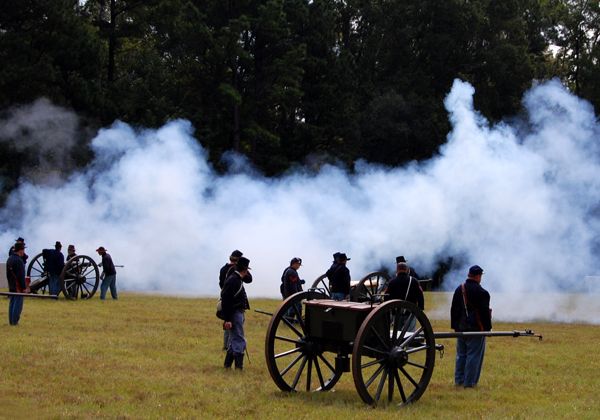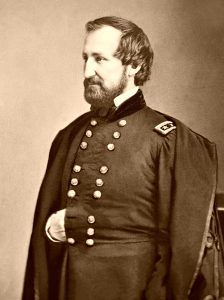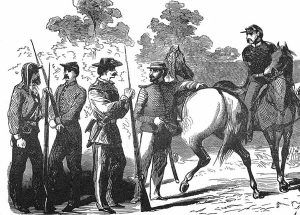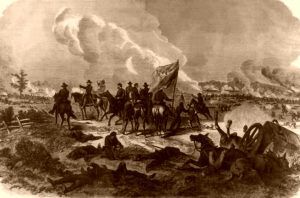The Battle of Chickamauga fought on September 19–20, 1863, marked the end of a Union offensive in southeastern Tennessee and northwestern Georgia called the Chickamauga Campaign. It was the most significant Union defeat in the Western Theater of the Civil War. It had the second-highest casualties following the Battle of Gettysburg, Pennsylvania.
Fought between the Union Army of the Cumberland under Major General William S. Rosecrans and the Confederate Army of Tennessee under General Braxton Bragg, it was named for West Chickamauga Creek, which meanders near the battle area in northwest Georgia and ultimately flows into the Tennessee River about 3.5 miles northeast of downtown Chattanooga, Tennessee.
Colonel Robert L. Kimberly wrote about the battle shortly afterward.
~~
“After midnight, the Union regiment, having passed Gordon’s Mills, went into a bivouac in a thicket near the road. The men felt they were on a battlefield and were glad enough to have the scanty rest before daylight should call them to action again. Nothing could be seen of the position, but it was sure that the troops were massed rather than strung out in a line, and the road was jammed with artillery and trains. In the morning, the regiment, with the rest, was moved toward Rossville, Georgia, on Chattanooga Road until it was near the Widow Glenn House, where Union Major General William Rosecrans’ headquarters had been established.
Further down the road and to the right of it, the sound of a severe engagement broke out about the middle of the forenoon. This was renewed repeatedly, and the report said that a force sent to dispute the enemy’s passage of the Chickamauga needed more than one reinforcement.
Finally, soon after noon, Major General John Palmer’s division was deployed in groups and moved straight across the Rossville Road to the attack. No enemy was in sight when the movement began. The troops’ objective was striking and crushing the enemy’s left flank. The movement started in an open wood; beyond this was a large open field and a woodland strip about halfway across it. The 41st was in the first echelon and advanced to the woodland. But, beyond this, the fighting was terrific. A storm of rifle balls came from the edge of the woods in front, and batteries were in rapid action at the back of this. The battle swept away to the right, and it was plain that the enemy’s flank was not found.
The 41st Infantry fired its last cartridges and was recalled to replenish the boxes. This was done hurriedly, back in the open wood. It was hardly finished when the enemy fell furiously on Brigadier General Horatio P. Van Cleve’s division, which was on the right of Palmer’s. Brigadier General William Hazen was near the 41st when this happened. Some idle batteries were at hand, and Hazen quickly posted these to check the onslaught, for Van Cleve’s men were beginning to come back. Then, the brigade was moved into the storm’s path, bearing back Van Cleve’s division. Colonel Aquila Wiley broke his line to the rear by companies to let the retreating crowds pass through and then wheeled back into line.
The 41st Infantry was still in the open wood, and in front was a large cornfield. The Confederates were swarming through this, but their first line had spent its force and lost its formation. Close behind came the second line in perfect order. Van Cleve’s retreating regiments had broken up Hazen’s line as they swept through, but the 41st had kept in form by breaking to the rear to let the fugitives pass, as has been told. Wiley opened on the Confederate second line, with volleys by front and rear ranks, instantly checking the advance. But, it was soon apparent that the regiment was out-flanked. Shots began to come from the right rear. Then Wiley changed front to face to the right and sent a volley into the gathering enemy. Then a change back, face the front, and check the main advance. Never had the marvelous effect of volley firing been more clearly demonstrated; the fiery Confederates could not stand against it. The closed ranks of the 41st were in sharp contrast with the loose line in front and the wandering foes on the right. The regiment fell back while loading a hundred yards at a time and easily held the enemy at bay. Then, a commanding crest was reached, where a battery had taken post. Here it was proposed to stand, but the enemy did not come on. He was reforming his lines, as could be seen from the crest. But night drew near, and the battle was over for the day.

Re-enactors fire cannons during the 149th Anniversary of the Battle of Chickamauga, Georgia. Photo by Dave Alexander.
Much of the night was spent getting into a new position—slow and tiresome marching in the darkness. The next morning, before the enemy moved, the 41st was lying behind a barricade of rails and logs, an open field behind it. There were troops to the right and left, showing that a general battle line was posted. Rations were not abundant, and there was none of the water.
A detail was sent to fill canteens; the men did not return but fell into the hands of the enemy, who held the water supply that was ours the day before. The intense suffering occasioned by this lack of water can hardly be imagined; hunger pangs seemed mild in comparison. Before night, men’s tongues were swollen, and their lips blackened and cracked until the power of speech was gone. It was far on into the next night when that time of awful thirst was ended.
The morning was well along when it became apparent that the enemy was advancing upon the Union lines. Nothing was to be seen in the woods to the front, but soon, the well-known Confederate yell was heard, and the skirmishers became engaged, falling back before the enemy’s line of battle. Then, the line was in view, coming on with true Southern impetuosity.
Behind its rails barricade, the 41st opened fire, and the fight was on to the right and left. The Confederates returned the fire with spirit, but their advance was checked, and they did little or no damage to the men behind the barricades.
The attacking line rapidly thinned out under the steady fire; then, it became unsteady, and finally, it turned and fled. This was the regiment’s first experience behind a defended line. Slight as was that defense of rails, it changed the whole fighting character. The enemy was severely punished, as was plain to be seen and had been able to make no return in kind. The men wondered if an attacking force could cover three hundred yards or so before a well-directed fire should destroy it.
But, the battle was not over with this one successful defense. The Confederate line overlapped the Union left and forced it back until it was stretched across the open field in the rear and at a right angle with the general line. Then there was a brave fight on both sides in the open ground. It was seen from the position held by the 41st, and it was most eagerly watched. If those men on the flank failed to maintain their ground, the whole line would be taken in the rear while it was assaulted in front. There were some moments of intense anxiety, and then it was seen that the Confederate assault had spent its force. It was as stubborn a fight as one could wish to see, but the Union troops’ staying quality won. Baird’s and Johnson’s divisions were on the left of Palmer’s.
This doubling up of a flank occurred again that day — the second time, the right flank. This came from a break in the Union line, made not by the enemy but by order from the commanding general. A division (Wood’s) was withdrawn from its place in line, and the enemy entered the gap at once. The army was cut in two, and most of the right was driven from the field. The general of the army went as far as Chattanooga. The Confederates pushed their advantage toward the Union left until the division next to Palmer’s right was bent back to the rear. This, like the flank attack on the left, was in view from the position of the 41st and was watched as anxiously. Like the other flanking operation, this one failed, thanks to nothing but the steadiness of the Union troops.
But, while these things took place in front and oil both flanks, another peril began to grow in the consciousness of the men who could not be driven from front or flank. The cartridge boxes were rapidly emptied, and no ammunition train was near. Everything seemed to have been swept away with the right wing. Then, from the woods across the open field in the rear, bullets began to whistle toward the backs of the men in the line. These shots were supposed to come from sharpshooters in the trees. A company of the 41st was faced about and delivered a volley into the treetops across the open. This had a good effect; there was one danger less. But, the question of ammunition pressed. Nobody knew where to find it. The four divisions of the left wing were holding their ground, but they were out of communication with the rest of the army, wherever that might be, and they had no supplies of any kind. The division generals came together, and the question of a commander came up. The three corps of the army were represented in those four divisions, but no corps commander was present. None of the division generals coveted the command responsibility, but it was plain that something must be done. There was heavy firing off to the right, and it was guessed that Thomas was holding out against the enemy that had swept away the right wing somewhere in that direction.
Finally, Hazen volunteered to take his brigade across the interval and communicate with whatever Union force might be still in the field. The brigade was withdrawn from the line, marched somewhat to the rear, and then started through the unexplored woods toward the sound of battle. The movement was made cautiously but rapidly, the brigade constantly in readiness for any fortune that might occur. Some scattered Confederates were in the woods, and a Confederate skirmish line was struck obliquely, but no other force was encountered. The way seemed miles longer than it was, and the relief was great when the leading regiment came upon the left of the position where General George Thomas had stopped the victorious enemy and held him steadfastly. Thomas himself, beloved of all the army, rode up to take Hazen by the hand. The arrival was just in time. A desperate assault was about to come on the left of Thomas’s line. Hazen’s men marched through a cornfield to the crest of a low hill and were there massed in a column of regiments. Scarcely was this done when the Confederate storm burst. The slope in front of the brigade was open ground, and in a moment, this was covered with heavy masses of the enemy making for the top. Hazen’s regiments were lying flat. The foremost sprang to its feet, delivered its volley, and went down again to load, and the next regiment just behind rose to fire and fall flat while the third put in its work, and so on. The slope was strewn with Confederate dead and wounded, but no man could reach the crest. Along the rest of the line also, the defense was successful. The night was falling fast, and the Battle of Chickamauga was over.”
By Colonel Robert L. Kimberly
~~
A Confederate victory, the Union, retired to Chattanooga, Tennessee, while the Confederates occupied the surrounding heights. Chickamauga was an extremely costly battle for both armies. The Union suffered an estimated 16,170 casualties (wounded, killed, captured, or missing), while the Confederates sustained approximately 18,454.
Compiled and edited by Kathy Alexander/Legends of America, updated October 202r.
Notes and Author: This article was primarily written by Colonel Robert L. Kimberly and included as a chapter in Albert Bushnell Hart’s book The Romance of the Civil War, published in 1896. However, as it appears here, the article is not verbatim and has been heavily edited, with additional information included.
Also See:




